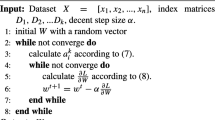Abstract
Recently, exactly recovering the intrinsic data structure from highly corrupted observations, which is known as robust principal component analysis (RPCA), has attracted great interest and found many applications in computer vision. Previous work has used RPCA to remove shadows and illuminations from face images. To go further, this paper introduces a method to use RPCA directly for recognition. And the inexact Augmented Lagrange Multiplier algorithm (ALM) is used to solve the RPCA problem. We actually utilize RPCA to reconstruct the testing sample from the training samples and compare the reconstructed one with the original one to do classification. Although the method is not very complicated, through experiments on some face databases we can see that it has better performance compared with some existing methods, especially under rigorous circumstances of occlusions and illuminations.
Access this chapter
Tax calculation will be finalised at checkout
Purchases are for personal use only
Preview
Unable to display preview. Download preview PDF.
Similar content being viewed by others
References
Eckart, C., Young, G.: The approximation of one matrix by another of lower rank. Psychometrika 1, 211–218 (1936)
Hotelling, H.: Analysis of a complex of statistical variables into principal components. Journal of Educational Psychology 24, 417–441 (1933)
Jolliffe, I.: Principal Component Analysis. Springer (1986)
Ma, Y., Derksen, H., Hong, W., Wright, J.: Segmentation of multivariate mixed data via lossy data coding and compression. IEEE Trans. Pattern Anal. Mach. Intell. 29(9), 1546–1562 (2007)
Candes, E.J., Li, X., Ma, Y., Wright, J.: Robust principal component analysis? J. ACM 58, 11:1–11:37 (2011)
Lin, Z., Chen, M., Ma, Y.: The Augmented Lagrange Multiplier Method for Exact Recovery of Corrupted Low-Rank Matrix. Technical Report UILU-ENG-09-2215, UIUC, arXiv: 1009.5055 (2009)
Yin, W., Hale, E., Zhang, Y.: Fixed-point continuation for ℓ1-minimization: Methodology and convergence (2008) (preprint)
Yin, W., Osher, S., Goldfarb, D., Darbon, J.: Bregman iterative algorithms for ℓ1-minimization with applications to compressed sensing. SIAM Journal on Imaging Sciences 1(1), 143–168 (2008)
Beck, A., Teboulle, M.: A fast iterative shrinkage-thresholding algorithm for linear inverse problems. SIAM Journal on Imaging Sciences 2(1), 183–202 (2009)
Tseng, P.: On accelerated proximal gradient methods for convex-concave optimization. SIAM Journal on Optimization (2008) (submitted)
Nesterov, Y.: A method of solving a convex programming problem with convergence rateO(1/k2). Soviet Mathematics Doklady 27(2), 372–376 (1983)
Ganesh, A., Lin, Z., Wright, J., Wu, L., Chen, M., Ma, Y.: Fast Algorithms for Recovering a Corrupted Low-Rank Matrix. In: International Workshop on Computational Advances in Multi-Sensor Adaptive Processing (2009)
Bertsekas, D.: Constrained Optimization and Lagrange Multiplier Method. Academic Press (1982)
Lee, K.C., Ho, J., Driegman, D.: Acquiring Linear Subspaces for Face Recognition under Variable Lighting. IEEE Trans. PAMI 27(5), 684–698 (2005)
Martinez, A.M., Benavente, R.: The AR Face Database. CVC Technical Report #24 (1998)
Zhang, L., Yang, M., Feng, X.C.: Sparse representation or collaborative representation which helps face recognition? In: ICCV (2011)
Naseem, I., Togneri, R., Bennamoun, M.: Linear Regression for Face Recognition. IEEE Trans. PAMI 32(11), 2106–2112 (2010)
Wright, J., Yang, A.Y., Ganesh, A., Sastry, S.S., Ma, Y.: Robust face recognition via sparse representation. IEEE Trans. PAMI 31(2), 210–227 (2009)
Author information
Authors and Affiliations
Editor information
Editors and Affiliations
Rights and permissions
Copyright information
© 2013 Springer-Verlag Berlin Heidelberg
About this paper
Cite this paper
Chen, Y., Yang, J. (2013). Robust Principal Component Analysis for Recognition. In: Sun, C., Fang, F., Zhou, ZH., Yang, W., Liu, ZY. (eds) Intelligence Science and Big Data Engineering. IScIDE 2013. Lecture Notes in Computer Science, vol 8261. Springer, Berlin, Heidelberg. https://doi.org/10.1007/978-3-642-42057-3_29
Download citation
DOI: https://doi.org/10.1007/978-3-642-42057-3_29
Publisher Name: Springer, Berlin, Heidelberg
Print ISBN: 978-3-642-42056-6
Online ISBN: 978-3-642-42057-3
eBook Packages: Computer ScienceComputer Science (R0)




